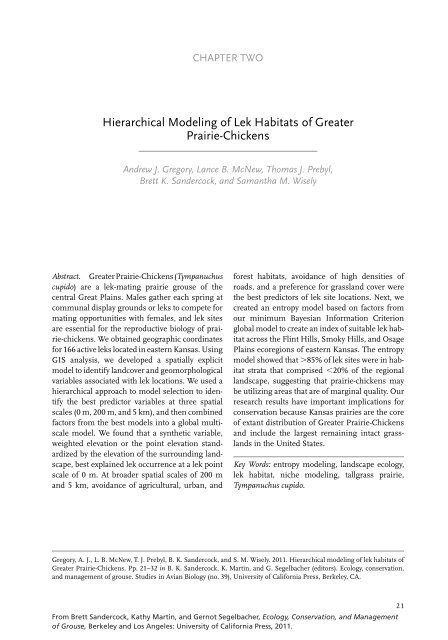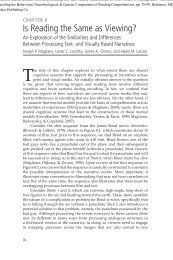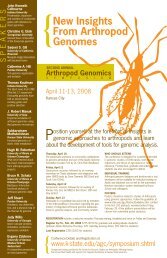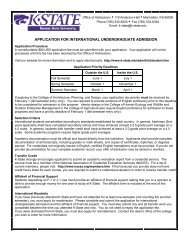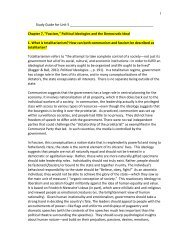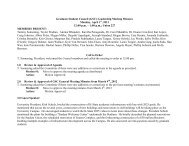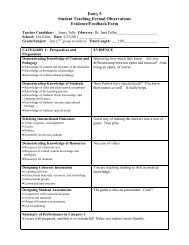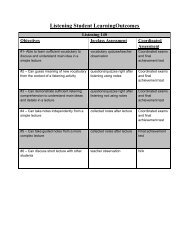Hierarchical Modeling of Lek Habitats of Greater Prairie-Chickens
Hierarchical Modeling of Lek Habitats of Greater Prairie-Chickens
Hierarchical Modeling of Lek Habitats of Greater Prairie-Chickens
You also want an ePaper? Increase the reach of your titles
YUMPU automatically turns print PDFs into web optimized ePapers that Google loves.
CHAPTER TWO<br />
<strong>Hierarchical</strong> <strong>Modeling</strong> <strong>of</strong> <strong>Lek</strong> <strong>Habitats</strong> <strong>of</strong> <strong>Greater</strong><br />
<strong>Prairie</strong>-<strong>Chickens</strong><br />
Andrew J. Gregory, Lance B. McNew, Thomas J. Prebyl,<br />
Brett K. Sandercock, and Samantha M. Wisely<br />
Abstract. <strong>Greater</strong> <strong>Prairie</strong>-<strong>Chickens</strong> ( Tympanuchus<br />
cupido) are a lek-mating prairie grouse <strong>of</strong> the<br />
central Great Plains. Males gather each spring at<br />
communal display grounds or leks to compete for<br />
mating opportunities with females, and lek sites<br />
are essential for the reproductive biology <strong>of</strong> prairie-chickens.<br />
We obtained geographic coordinates<br />
for 166 active leks located in eastern Kansas. Using<br />
GIS analysis, we developed a spatially explicit<br />
model to identify landcover and geomorphological<br />
variables associated with lek locations. We used a<br />
hierarchical approach to model selection to identify<br />
the best predictor variables at three spatial<br />
scales (0 m, 200 m, and 5 km), and then combined<br />
factors from the best models into a global multiscale<br />
model. We found that a synthetic variable,<br />
weighted elevation or the point elevation standardized<br />
by the elevation <strong>of</strong> the surrounding landscape,<br />
best explained lek occurrence at a lek point<br />
scale <strong>of</strong> 0 m. At broader spatial scales <strong>of</strong> 200 m<br />
and 5 km, avoidance <strong>of</strong> agricultural, urban, and<br />
forest habitats, avoidance <strong>of</strong> high densities <strong>of</strong><br />
roads, and a preference for grassland cover were<br />
the best predictors <strong>of</strong> lek site locations. Next, we<br />
created an entropy model based on factors from<br />
our minimum Bayesian Information Criterion<br />
global model to create an index <strong>of</strong> suitable lek habitat<br />
across the Flint Hills, Smoky Hills, and Osage<br />
Plains ecoregions <strong>of</strong> eastern Kansas. The entropy<br />
model showed that 85% <strong>of</strong> lek sites were in habitat<br />
strata that comprised 20% <strong>of</strong> the regional<br />
landscape, suggesting that prairie-chickens may<br />
be utilizing areas that are <strong>of</strong> marginal quality. Our<br />
research results have important implications for<br />
conservation because Kansas prairies are the core<br />
<strong>of</strong> extant distribution <strong>of</strong> <strong>Greater</strong> <strong>Prairie</strong>-<strong>Chickens</strong><br />
and include the largest remaining intact grasslands<br />
in the United States.<br />
Key Words: entropy modeling, landscape ecology,<br />
lek habitat, niche modeling, tallgrass prairie,<br />
Tympanuchus cupido.<br />
Gregory, A. J., L. B. McNew, T. J. Prebyl, B. K. Sandercock, and S. M. Wisely. 2011. <strong>Hierarchical</strong> modeling <strong>of</strong> lek habitats <strong>of</strong><br />
<strong>Greater</strong> <strong>Prairie</strong>-<strong>Chickens</strong>. Pp. 21–32 in B. K. Sandercock, K. Martin, and G. Segelbacher (editors). Ecology, conservation,<br />
and management <strong>of</strong> grouse. Studies in Avian Biology (no. 39), University <strong>of</strong> California Press, Berkeley, CA.<br />
From Brett Sandercock, Kathy Martin, and Gernot Segelbacher, Ecology, Conservation, and Management<br />
<strong>of</strong> Grouse, Berkeley and Los Angeles: University <strong>of</strong> California Press, 2011.<br />
21<br />
Sandercock_6480004_ch02.indd 21 7/18/11 11:39:16 AM
Conversion <strong>of</strong> native grasslands to agriculture<br />
has caused dramatic declines in prairie<br />
habitats since European settlement,<br />
and tallgrass prairie is one <strong>of</strong> the most highly<br />
endangered ecosystems in North America, with<br />
5% <strong>of</strong> the original area remaining (Samson<br />
and Knopf 1994). Eastern Kansas includes 90%<br />
<strong>of</strong> the tallgrass prairie ecosystem left in North<br />
America, and the Smoky Hills, Flint Hills, and<br />
Osage Plains ecoregions have been recognized<br />
as ecologically important because they are core<br />
areas for grassland birds, an avian community<br />
<strong>of</strong> conservation concern (Fitzgerald et al. 2000,<br />
Pashley et al. 2000, Brennan and Kuvlevsky 2005).<br />
Unfortunately, long-term changes in land use and<br />
rangeland management practices may be negatively<br />
impacting the regional population viability<br />
<strong>of</strong> grassland birds in Kansas (Powell 2006, With<br />
et al. 2008, Rahmig et al. 2009).<br />
<strong>Greater</strong> <strong>Prairie</strong>-<strong>Chickens</strong> (Tympanuchus cupido,<br />
hereafter “prairie-chickens”) are a prairie grouse<br />
that are native to the grasslands <strong>of</strong> North America<br />
(Schroeder and Robb 1993). <strong>Prairie</strong>-chickens<br />
have been extirpated from much <strong>of</strong> their<br />
historical range, and historic losses were likely<br />
due to anthropogenic conversion <strong>of</strong> grasslands<br />
to row crop agriculture. The core <strong>of</strong> the remaining<br />
range <strong>of</strong> the species is in eastern Kansas and<br />
adjacent states, and populations in Kansas have<br />
been declining for over 30 years (Svedarsky et al.<br />
2000, Rodgers 2008). The underlying causes for<br />
ongoing population declines are poorly understood<br />
but may be related to changes in land use<br />
practices or predator communities. Regardless<br />
<strong>of</strong> the cause, ongoing population declines are a<br />
serious conservation concern. Kansas is the core<br />
<strong>of</strong> the remaining range, and translocations <strong>of</strong><br />
birds from source populations in Kansas have<br />
been used to bolster population numbers and<br />
increase genetic diversity within relict populations<br />
<strong>of</strong> prairie-chickens in Illinois and Missouri<br />
(Bouzat et al. 1998, B. E. Jamison, pers. comm.).<br />
A better understanding <strong>of</strong> the distribution and<br />
habitat requirements <strong>of</strong> prairie-chickens will aid<br />
conservation for this species and the associated<br />
community <strong>of</strong> grassland birds.<br />
Wildlife habitat use is hierarchical, and animals<br />
make decisions about which areas to use at multiple<br />
spatial scales (Johnson 1980). At broad scales<br />
<strong>of</strong> ∼10 km, prairie-chickens may avoid unsuitable<br />
habitats within their large home ranges<br />
( Hamerstrom and Hamerstrom 1960, Prose 1985).<br />
At finer scales <strong>of</strong> ∼1 km, prairie-chickens may<br />
use different vegetative cover types for different<br />
purposes such as nesting, feeding, and roosting<br />
(Svedarsky 1988, McCarthy et al. 1994, Ryan et al.<br />
1998). When engaged in these activities, prairiechickens<br />
may select patches to reduce predation<br />
risk, to optimize their thermal environment, or to<br />
forage on important food plants (Buhnerkempe<br />
et al. 1984, Ryan et al. 1998). Heterogeneity among<br />
patches within landcover types provides different<br />
resources, and consequently some patches<br />
may be more desirable than others. At each spatial<br />
scale, prairie-chickens must make decisions<br />
about where to allocate time and energy, and habitat<br />
preferences at broader scales likely impact the<br />
choices available at finer spatial scales.<br />
We evaluated the suitability <strong>of</strong> the Flint Hills,<br />
Smoky Hills, and Osage Plains ecoregions <strong>of</strong><br />
Kansas based on multiscale geospatial modeling<br />
<strong>of</strong> lek site locations for <strong>Greater</strong> <strong>Prairie</strong>-<strong>Chickens</strong>.<br />
<strong>Lek</strong>s or booming grounds are communal display<br />
sites where male prairie-chickens congregate<br />
to display and mate with females. Male prairiechickens<br />
show high site fidelity to leks from one<br />
breeding season to the next, and lek locations can<br />
be relatively stable over time (Robel 1970, Nooker<br />
and Sandercock 2008). Most mating is thought<br />
to occur at lek sites, and consequently suitable<br />
lekking sites are a necessary component <strong>of</strong> prairiechicken<br />
habitat (Hamerstorm and Hamerstrom<br />
1960, Schroeder and Robb 1993). Female<br />
prairie-chickens usually nest in the vicinity <strong>of</strong> leks<br />
( km; Hamerstrom 1939, Schroeder 1991), and<br />
lek site location ought to serve as a proxy for the<br />
occurrence <strong>of</strong> suitable nesting habitat at a landscape<br />
scale. Indeed, one proposed mechanism for<br />
lek evolution (the hot spot hypothesis) hypothesizes<br />
that leks evolved as males settled and clustered<br />
on pathways used preferentially by females<br />
to travel between needed resources (Beehler and<br />
Foster 1988, Schroeder and White 1993).<br />
The primary goal <strong>of</strong> our landscape model was<br />
to identify suitable versus unsuitable habitat<br />
based on the location attributes <strong>of</strong> lek sites. We<br />
used a hierarchical modeling approach with three<br />
spatial scales <strong>of</strong> 0 m, 200 m, and 5 km, based on<br />
the movements and space use <strong>of</strong> prairie-chickens<br />
in Kansas (Robel et al. 1970). When modeling<br />
habitat suitability, even the most refined spatial<br />
scales are a coarse-grained approach to conservation,<br />
because we must assume that microhabitat<br />
features within identified habitat patches have<br />
22<br />
STUDIES IN AVIAN BIOLOGY NO. 39 Sandercock, Martin, and Segelbacher<br />
Sandercock_6480004_ch02.indd 22 7/18/11 11:39:16 AM
the potential to be improved with management<br />
practices. <strong>Prairie</strong>-chickens could be considered<br />
an umbrella species for grassland communities<br />
because the species requires large tracts <strong>of</strong> grasslands<br />
(Svedarsky 1988, Poiani et al. 2001). Our<br />
main goal was to identify areas in need <strong>of</strong> conservation<br />
or enhancement for prairie-chickens, but<br />
our modeling approach and research results also<br />
have conservation implications for other sensitive<br />
species <strong>of</strong> grassland birds (Herkert 1994, Brennan<br />
and Kuvlesky 2005).<br />
METHODS<br />
To create an index <strong>of</strong> suitable prairie-chicken habitat<br />
for our study region, we performed a geospatial<br />
analysis <strong>of</strong> 166 lek locations distributed across<br />
the Flint Hills, Smoky Hills, and Osage Plains<br />
ecoregions <strong>of</strong> Kansas (Fig. 2.1; Griffith et al.<br />
2008). Geographical coordinates <strong>of</strong> leks were<br />
collected as part <strong>of</strong> a 3-year population study <strong>of</strong><br />
prairie-chickens in eastern Kansas (2006–2008;<br />
L. B. McNew et al., this volume, chapter 15) and<br />
from lek surveys conducted by the Kansas Department<br />
<strong>of</strong> Wildlife and Parks (KDWP, 2005–2007).<br />
KDWP survey routes were originally established<br />
in the late 1950s at a sampling density <strong>of</strong> 1 route<br />
surveying 57.8 km 2 per county, but sampling<br />
efforts are being continually expanded. KDWP<br />
survey routes were not established in targeted<br />
areas with known prairie-chicken populations,<br />
but rather were selected based on the presence<br />
<strong>of</strong> large tracts <strong>of</strong> grassland habitat and relatively<br />
good access via county roads. For the purposes <strong>of</strong><br />
KDWP surveys, leks were defined as 3 males<br />
displaying in an area, and were located by listening<br />
for prairie-chicken booming at 1-mile intervals<br />
along the survey routes and by performing<br />
flush counts on located leks (R. D. Rodgers, pers.<br />
comm.). Our intensive population study was primarily<br />
conducted in Cloud, Geary, and Elk counties.<br />
For the intensive surveys, leks were also<br />
defined as 3 males displaying in an area and were<br />
located via listening along all county roads within<br />
the identified counties. We also sought landowner<br />
permission to survey large road-free tracts <strong>of</strong> land<br />
either on foot or with all-terrain vehicles.<br />
We used Arc Info 9.2 (Environmental Systems<br />
Research Institute, Redlands, CA) for all geospatial<br />
analysis and data extraction. We acquired all<br />
data sets from the Kansas Geospatial Community<br />
Commons (www.kansasgis.org). For land cover<br />
analyses, we used the 30-m resolution, 2005 land<br />
cover map <strong>of</strong> the State <strong>of</strong> Kansas (Kansas Applied<br />
Smoky Hills<br />
Flint Hills<br />
Osage Plains<br />
<strong>Lek</strong> locations<br />
Ecoregions<br />
Kansas counties<br />
Figure 2.1. Study area and lek sites <strong>of</strong> <strong>Greater</strong> <strong>Prairie</strong>-<strong>Chickens</strong> in eastern Kansas,<br />
2005–2008. Ecoregions represent areas <strong>of</strong> similar ecosystems and geomorphological<br />
characteristics. Black dots are locations <strong>of</strong> leks used for model development and validation.<br />
Inset map indicates the location <strong>of</strong> Kansas within the United States.<br />
HIERARCHICAL MODELING OF LEK HABITATS 23<br />
Sandercock_6480004_ch02.indd 23 7/18/11 11:39:16 AM
Remote Sensing Program 2005; Whistler et al.<br />
2006), which we reclassified to an Anderson Level I<br />
classification scheme, depicting five biologically<br />
relevant landcover classes: grassland, row crop agriculture,<br />
urban, forested, and water ( Anderson et al.<br />
1971). Grasslands included all CRP ( Conservation<br />
Reserve Program) lands, or grazed and ungrazed<br />
pastures <strong>of</strong> native prairie. Row crop agriculture<br />
included croplands plus all tillable acres. Urban<br />
areas were defined as all cities, towns, roads, and<br />
human dwellings. Forested lands included gallery<br />
forests and riparian corridors, whereas water<br />
included rivers, streams, stock ponds, and reservoirs.<br />
For geomorphological analyses, we used the<br />
30-m resolution 1999 National Elevation Dataset<br />
(U.S. Geological Survey, EROS Data Center). We<br />
also included a 1991 Riparian Inventory data set<br />
for the state <strong>of</strong> Kansas (U.S. Department <strong>of</strong> Agriculture,<br />
Natural Resources Conservation Service)<br />
and a roadway data set that combined the 2006<br />
Kansas State and Non-State Road System data sets<br />
(Kansas Department <strong>of</strong> Transportation, Bureau <strong>of</strong><br />
Transportation Planning). Each land cover data set<br />
was aggregated to 100-m grain size prior to landscape<br />
analysis.<br />
To assess differences in landscape and habitat<br />
features <strong>of</strong> lek sites versus potentially available<br />
landscape features and habitats, 132 random<br />
points were generated within the same spatial<br />
extent as lek locations using Arc Info 9.2 and<br />
were later used in logistic regression model fitting.<br />
Prior to model fitting procedures, we randomly<br />
selected 34 <strong>of</strong> 166 (20%) lek locations and<br />
an additional 34 randomly generated locations<br />
and withheld them from model development to<br />
be used for model validation.<br />
To evaluate characteristics <strong>of</strong> the area surrounding<br />
lek sites at a landscape spatial scale,<br />
we buffered each lek site with a 5-km neighborhood<br />
radius which evaluated landscape patterns<br />
at large spatial scale. Females typically<br />
choose nesting sites within 2 km <strong>of</strong> lek locations<br />
( Hamerstrom 1939, Schroeder 1991), and the<br />
average home range size <strong>of</strong> a prairie-chicken in<br />
Kansas is 500 ha (Robel 1970). Thus a 5-km buffer<br />
was selected to encompass possible nesting<br />
habitats around lek sites. For the intermediate<br />
spatial scale, we analyzed lek habitat characteristics<br />
within overlapping neighborhoods <strong>of</strong> 200 m<br />
radii, a distance that would likely characterize the<br />
habitat used for lekking itself. Analysis at these<br />
two spatial scales tested whether characteristics<br />
<strong>of</strong> the landscape surrounding lek sites influenced<br />
the presence or absence <strong>of</strong> leks. We used<br />
neighborhood statistics to calculate the percent<br />
area for each <strong>of</strong> the six landcover types and<br />
Fragstats 3.3 to calculate the total core area <strong>of</strong><br />
grassland patches using the eight neighbor patch<br />
rule and 100 m edge depth (McGarigal and Marks<br />
1995). Within neighborhoods, we calculated the<br />
density <strong>of</strong> all roads (km per km 2 ) as an index <strong>of</strong><br />
disturbance, and the density <strong>of</strong> 10-m elevational<br />
contour lines as an index <strong>of</strong> habitat complexity<br />
or topographic relief.<br />
At the finest spatial scale at 0 m or the point<br />
<strong>of</strong> the lek, we measured attributes <strong>of</strong> the geographic<br />
center <strong>of</strong> the lek. We recorded four variables:<br />
distance to riparian areas, distance to urban<br />
areas, distance to roads, and weighted elevation.<br />
Weighted elevation was a synthetic variable that<br />
compared the absolute elevation <strong>of</strong> the lek site<br />
relative to the surrounding landscape, calculated<br />
as the elevation <strong>of</strong> the lek location divided by the<br />
average elevation <strong>of</strong> all grid centroid points within<br />
1 km <strong>of</strong> the location. Use <strong>of</strong> weighted elevations<br />
standardized the topographic positions <strong>of</strong> leks<br />
within our study region to values ranging from<br />
0.7 to 2.0. All measured variables were extracted<br />
from landscape data for both known lek sites and<br />
an equal number <strong>of</strong> random points.<br />
Prior to model construction, all variables were<br />
standardized by z-transformations to normal<br />
distributions with a mean <strong>of</strong> zero and a standard<br />
deviation <strong>of</strong> 1, so that β coefficients from<br />
the resulting models were in the same units and<br />
would be directly comparable. We employed a<br />
hierarchical approach to model selection. Factors<br />
from each spatial scale were first entered into separate<br />
logistic regression models, and then significant<br />
factors were combined into a global model<br />
that pooled important variables across multiple<br />
scales. Our hierarchical model selection process<br />
consisted <strong>of</strong> Bayesian model selection at each <strong>of</strong><br />
three spatial scales, followed by a second round<br />
<strong>of</strong> model selection for models with factors at multiple<br />
spatial scales (Schwarz 1978, Hosmer et al.<br />
1997). <strong>Hierarchical</strong> procedures were used to avoid<br />
spatial autocorrelation between data sets. Spatial<br />
autocorrelation between scales can occur because<br />
scales are nested within each other hierarchically.<br />
<strong>Hierarchical</strong> procedures adjust for spatial autocorrelation<br />
by allowing models to be developed<br />
for each scale independently and then concatenated<br />
across scales. During the concatenation<br />
24 STUDIES IN AVIAN BIOLOGY NO. 39 Sandercock, Martin, and Segelbacher<br />
Sandercock_6480004_ch02.indd 24 7/18/11 11:39:28 AM
process, if variables are correlated across scales<br />
they are unlikely to be included because <strong>of</strong> the<br />
penalty associated with adding extra parameters.<br />
Bayesian model selection (BIC) procedures were<br />
used for model selection (Anderson et al. 2000,<br />
Johnson and Omland 2004), because these statistics<br />
tend to be more conservative and less likely to<br />
over-fit data than Akaike’s Information Criterion<br />
(Burnham and Anderson 2004). A conservative<br />
approach to model selection was desirable to compensate<br />
for highly spatially correlated data sets.<br />
Principal components analysis or factor analysis<br />
could have been used to address this issue, but<br />
we did not use multivariate techniques because<br />
we were primarily interested in the effects <strong>of</strong> our<br />
original landscape variables. Use <strong>of</strong> the untransformed<br />
landscape data was important because<br />
we wanted to apply model predictions directly<br />
to spatially explicit ecological niche modeling.<br />
Improved GIS analysis techniques allow many<br />
landscape metrics to be calculated, but our goal<br />
was to ensure that only biologically relevant and<br />
statistically meaningful metrics were included in<br />
our analysis (McGarigal and Marks 1995).<br />
Landscape variables from the minimum BIC<br />
multiscale model were used as data inputs for ecological<br />
niche modeling using program MaxEnt.<br />
Program MaxEnt uses entropy theory to model<br />
landscape suitability based only on presence data<br />
and to integrate analyses across spatial scales<br />
(Phillips et al. 2004); it has several advantages<br />
compared to other s<strong>of</strong>tware for ecological niche<br />
modeling, including program GARP ( Phillips<br />
et al. 2006, Austin 2007). However, program<br />
MaxEnt and other niche modeling s<strong>of</strong>tware packages<br />
tend to overestimate landscape suitability<br />
when many environmental variables are used, but<br />
a conservative model selection procedure based<br />
on BIC should have ameliorated this possibility<br />
(Phillips et al. 2006). Ecological niche modeling<br />
yielded a preliminary index <strong>of</strong> suitable prairiechicken<br />
lek habitat across the Flint Hills, eastern<br />
Smoky Hills, and Osage Plains regions <strong>of</strong> Kansas.<br />
We validated our model by using a random 20%<br />
subset <strong>of</strong> our lek points that were withheld from<br />
model development, and assessed the proportion<br />
<strong>of</strong> leks that mapped onto each <strong>of</strong> the suitability<br />
categories <strong>of</strong> our index. We also compared the<br />
suitability <strong>of</strong> the landscape as predicted from<br />
our hierarchical model to the suitability <strong>of</strong> the<br />
landscape as predicted by models based on each<br />
<strong>of</strong> the single spatial scales.<br />
RESULTS<br />
Environmental Covariates<br />
At each spatial scale, our analysis indicated different<br />
features <strong>of</strong> the landscape were influencing lek<br />
presence. At the broadest scale, which described<br />
the area adjacent to leks in a 5-km neighborhood,<br />
five <strong>of</strong> six competing models each received<br />
some support (w i 0.11; Table 2.1). In general,<br />
the broad-scale models indicated that lek occurrence<br />
was negatively associated with percent forest<br />
area, road density, and urban area within the<br />
region, but was weakly and positively associated<br />
with percent grassland cover and the total core<br />
grassland area in a 5-km neighborhood. All possible<br />
candidate models for these variables were considered.<br />
Using a logistic model describing relative<br />
probability <strong>of</strong> lek occurrence conditional on habitat<br />
variables, the minimum BIC model included<br />
three variables: percent urban cover, road density,<br />
and percent forest cover: leks 1.08 5.92 <br />
percent urban area 1.39 road density 0.76 <br />
percent forest.<br />
At the lek habitat scale <strong>of</strong> a 200-m neighborhood,<br />
the global model included percent land<br />
coverage for forest, agriculture, urban, grassland,<br />
crop, and an estimate <strong>of</strong> topographic relief based<br />
on density <strong>of</strong> contour lines. All possible candidate<br />
models for the variables included in the global<br />
model were evaluated. Our selection procedure<br />
indicated that a single candidate model received<br />
99% <strong>of</strong> the model support (Table 2.1), which indicated<br />
that lek habitat at a neighborhood <strong>of</strong> 200 m<br />
was most strongly influenced by a negative association<br />
with cover <strong>of</strong> row crop agriculture: leks <br />
0.01 – 0.46 percent agriculture.<br />
At a lek point scale <strong>of</strong> 0 m, the global model<br />
included four variables: distance to roads, urban<br />
areas, forest, and weighted elevation. Of all<br />
possible candidate models for these four variables,<br />
two models received similar levels <strong>of</strong> support<br />
(w i 0.45; Table 2.1). The minimum BIC model,<br />
which received 49% <strong>of</strong> the model support, modeled<br />
lek sites as a function <strong>of</strong> both the weighted<br />
elevation and the distance from urban centers:<br />
leks 0.003 1.34 weighted elevation 0.36 <br />
distance to urban areas. A second model, which<br />
received 46% <strong>of</strong> the model support, modeled lek<br />
site location as a function <strong>of</strong> weighted elevation.<br />
To understand the importance <strong>of</strong> different spatial<br />
scales in habitat selection, we reran the model<br />
selection procedure combining different scales.<br />
HIERARCHICAL MODELING OF LEK HABITATS 25<br />
Sandercock_6480004_ch02.indd 25 7/18/11 11:39:28 AM
TABLE 2.1<br />
Bayesian model selection to identify landscape attributes associated with lek sites <strong>of</strong> <strong>Greater</strong> <strong>Prairie</strong>-<strong>Chickens</strong><br />
in eastern Kansas, 2005–2008.<br />
Hosmer-Lemeshow<br />
Model K 2 ln (K) BIC ΔBIC w i C P<br />
Habitat Models 5 km<br />
%Urban, % Frst, Rd. Den 4 286.9 309.3 0.0 0.33 0.80 0.03<br />
%Grass, %Urban, %Frst 4 287.7 310.0 0.7 0.24 0.78 0.07<br />
%Frst, Rd. Den 3 293.8 310.6 1.3 0.18 0.79 0.04<br />
%Urban, %Frst, Rd. Den, ALGP 5 283.1 310.9 1.6 0.14 0.80 0.04<br />
%Grass, %Urban, %Frst, Rd. Den 5 283.5 311.4 2.1 0.12 0.80 0.04<br />
C-Den, %Ag, %CRP, &Grass, %Urban,<br />
%H 2 O, %Frst, Rd. Den, ALGP<br />
10 270.5 326.2 16.9 0.01 0.82 0.86<br />
Habitat Models 200 m<br />
%Ag 2 227.3 271.9 0.0 0.99 0.66 0.01<br />
C-Den, %Ag, %CRP, %Grass,<br />
%Urban, %H 2 O<br />
8 353.0 364.1 92.0 0.01 0.86 0.02<br />
%Frst<br />
Points Models 0 m<br />
D-Urb, Wt-Elev 3 281.3 298.1 0.0 0.49 0.82 0.01<br />
Wt-Elev 2 287.0 298.1 0.1 0.46 0.82 0.01<br />
Multi-Scale Model<br />
%Grass 5 km, %Urban 5 km,<br />
Wt-Elev<br />
4 230.2 262.7 0.0 0.42 0.85 0.05<br />
%Urban 5 km, %Frst 5 km,<br />
Rd. Den 5 km, Wt-Elev<br />
%Urban 5 km, %Frst 5 km,<br />
Rd. Den 5 km, ALGP, Wt-Elev<br />
%Grass 5 km, %Urban 5 km,<br />
%Frst 5 km, Rd. Den 5 km, D-Urb,<br />
ALGP, Wt-Elev<br />
5 259.3 263.2 0.6 0.32 0.88 0.06<br />
6 259.2 263.6 0.9 0.26 0.88 0.09<br />
8 223.4 273.6 10.9
minimum BIC model, which received 42% <strong>of</strong> the<br />
total model support, indicated strong avoidance<br />
<strong>of</strong> urban areas and preference for relatively high<br />
sites with grassland cover: leks 1.02 – 6.62 <br />
percent urban area at 5 km 1.21 weighted<br />
elevation 0.43 percent grassland at 5 km.<br />
Other parsimonious models had similar coefficients<br />
for these three factors, but also included<br />
weak effects for avoidance <strong>of</strong> areas with high road<br />
density or forests and a preference for lek sites<br />
close to large grassland patches.<br />
Niche <strong>Modeling</strong><br />
We used the minimum BIC multiscale model and<br />
program MaxEnt to create an index <strong>of</strong> suitable lek<br />
habitat for the three ecoregions in our study area<br />
(Fig. 2.2). Our niche model predicted that highly<br />
suitable habitat for leks was found at or near the<br />
highest point on the surrounding landscape. The<br />
average weighted elevation was 1.07 0.07 SE,<br />
and highly suitable areas were comprised <strong>of</strong> 90%<br />
grassland and 8% agriculture, with 2% <strong>of</strong> the<br />
landscape surrounding leks being forest, water,<br />
or urban habitats. Moderately suitable areas were<br />
similar to highly suitable areas in having an average<br />
weighted elevation <strong>of</strong> 1.02 0.07 SE, but<br />
had less grassland (77%) and more agriculture<br />
(20%) than highly suitable areas; other habitats<br />
accounted for ∼3% <strong>of</strong> the landscape. In contrast,<br />
low suitability areas were usually distributed in<br />
low-lying areas <strong>of</strong> the landscape and had an average<br />
weighted elevation <strong>of</strong> 0.87 0.22 SE. Lowelevation<br />
habitats in our study area frequently<br />
included gallery forests, river beds and flood<br />
plains, row crop agricultural areas, and urbanized<br />
developments. Overall, low-suitability areas were<br />
comprised <strong>of</strong> 51% grassland, 33% agriculture, 9%<br />
forests, 4% urban, and 3% water.<br />
Overall, our model predicted that lek sites<br />
would occur at or near the highest point on the<br />
landscape away from forests, large bodies <strong>of</strong> water,<br />
or urban centers, in areas comprised primarily <strong>of</strong><br />
grassland with slight to moderate amounts <strong>of</strong> row<br />
crop agriculture. We created similar indices <strong>of</strong> lek<br />
habitat suitability for the minimum BIC models<br />
at each single spatial scale and compared the<br />
area <strong>of</strong> suitable habitat predicted by these indices<br />
to the area predicted by the multiscale grand<br />
model. Predictions from models based on a spatial<br />
scale <strong>of</strong> 0 m and 5 km were most similar to<br />
the predictions <strong>of</strong> the multiscale model (Fig. 2.3),<br />
presumably because environmental covariates at<br />
these spatial scales had the strongest effects on<br />
lek occurrence, as measured by the slope coefficients<br />
for z-transformed landscape covariates.<br />
Suitability index<br />
Figure 2.2. Map <strong>of</strong> habitat suitability based on maximum entropy modeling <strong>of</strong> lek sites <strong>of</strong><br />
<strong>Greater</strong> <strong>Prairie</strong>-<strong>Chickens</strong> in eastern Kansas, 2005–2008.<br />
HIERARCHICAL MODELING OF LEK HABITATS 27<br />
Sandercock_6480004_ch02.indd 27 7/18/11 11:39:29 AM
100%<br />
90%<br />
80%<br />
Landscape composition<br />
70%<br />
60%<br />
50%<br />
40%<br />
30%<br />
20%<br />
10%<br />
0%<br />
Point<br />
200 m<br />
5 km Grand Lnd. cov.<br />
High<br />
Medium<br />
Low<br />
Figure 2.3. Comparisons <strong>of</strong> habitat suitability <strong>of</strong> our study area as predicted by models for<br />
three spatial scales (0 m, 200 m, and 5 km), a multi-scale model (Grand), and a model based<br />
solely on land cover (Lnd. cov.).<br />
100%<br />
90%<br />
80%<br />
Suitability composition<br />
70%<br />
60%<br />
50%<br />
40%<br />
30%<br />
20%<br />
10%<br />
0%<br />
Validation leks<br />
Model leks<br />
Total predicted landscape<br />
High<br />
Medium<br />
Low<br />
Figure 2.4. Comparisons <strong>of</strong> habitat suitability among a random set <strong>of</strong> leks used for model<br />
validation (n 34), lek locations used for model development (n 132), and the entire<br />
study area (Landscape).<br />
During validation procedures, the final multiscale<br />
model was able to distinguish between randomly<br />
selected lek sites and randomly plotted<br />
points (t 3.9, df 35, P 0.001). Moreover,<br />
88.2% <strong>of</strong> the randomly selected validation leks<br />
(n 34) were correctly classified into suitable<br />
habitat. We next plotted geographic coordinates<br />
<strong>of</strong> random leks onto the multiscale lek habitat<br />
suitability index to determine what proportion <strong>of</strong><br />
these leks occurred in each <strong>of</strong> the three suitability<br />
categories, and compared the proportions to the<br />
frequency <strong>of</strong> occurrence <strong>of</strong> each habitat type in<br />
the landscape as a whole (Fig. 2.4). The top three<br />
models gave similar predictions, and in all cases<br />
28<br />
STUDIES IN AVIAN BIOLOGY NO. 39 Sandercock, Martin, and Segelbacher<br />
Sandercock_6480004_ch02.indd 28 7/18/11 11:39:30 AM
the leks had substantially higher levels <strong>of</strong> suitability<br />
than the entire landscape. A total <strong>of</strong> 85–90% <strong>of</strong><br />
the lek sites occurred in habitat areas <strong>of</strong> moderate<br />
to high suitability, yet only 5–20% <strong>of</strong> the total<br />
landscape included habitats that met these criteria<br />
for <strong>Greater</strong> <strong>Prairie</strong>-<strong>Chickens</strong> (Fig. 2.4).<br />
DISCUSSION<br />
Our hierarchical approach to ecological niche<br />
modeling showed that 85% <strong>of</strong> lek sites <strong>of</strong> <strong>Greater</strong><br />
<strong>Prairie</strong>-<strong>Chickens</strong> were in habitat strata that comprised<br />
20% <strong>of</strong> the regional landscape in eastern<br />
Kansas. Our results are somewhat discouraging<br />
because Kansas prairies are considered to be<br />
the last remaining strongholds for conservation<br />
<strong>of</strong> grassland birds in the U.S. ( Fitzgerald et al.<br />
2000, Pashley et al. 2000). We expected that the<br />
environmental correlates <strong>of</strong> lek site selection<br />
might vary across the geographic distribution <strong>of</strong><br />
prairie- chickens if differences in the degree <strong>of</strong><br />
habitat fragmentation affected lek placement.<br />
An estimated 36–45% <strong>of</strong> the landscape <strong>of</strong> our<br />
Kansas study area is comprised <strong>of</strong> intact grasslands<br />
( Applegate et al. 2003, A. J. Gregory and<br />
D. G. Goodin, unpubl. data). Previous analyses<br />
<strong>of</strong> lek habitat suitability have been conducted in<br />
more fragmented landscapes in Minnesota and<br />
Wisconsin, where grasslands are part <strong>of</strong> a patchy<br />
mosaic in a matrix <strong>of</strong> forest, wetlands, and row crop<br />
agriculture ( Merrill et al. 1999, Niemuth 2003).<br />
Despite potential differences in landscape<br />
configuration, our major findings were consistent<br />
with previous analyses <strong>of</strong> lek site selection<br />
for prairie-chickens. Grassland cover at 5 km<br />
was a relevant factor in our multiscale model for<br />
Kansas, which is consistent with previous studies<br />
that have identified cover or size <strong>of</strong> grassland<br />
patches as important factors in determining the<br />
presence <strong>of</strong> prairie-chicken leks elsewhere in<br />
their range (Hamerstrom et al. 1957, Kirsch 1974,<br />
Merrill et al. 1999, Niemuth 2003). Although<br />
grassland cover was relevant in Kansas, we found<br />
that relative elevation at the lek location, a lack<br />
<strong>of</strong> agriculture within 200 m, and a lack <strong>of</strong> urban<br />
areas, forest, and roads within 5 km were better<br />
predictors <strong>of</strong> lek presence. Grassland cover alone<br />
has previously been found to be a poor predictor<br />
<strong>of</strong> lek location in fragmented landscapes,<br />
and avoidance <strong>of</strong> areas with residential development<br />
and forest cover appears to be a general<br />
finding for lek site selection by prairie-chickens<br />
( Merrill et al. 1999, Niemuth 2003). In the prairiedominated<br />
landscapes <strong>of</strong> eastern Kansas, the<br />
amount <strong>of</strong> grassland available may be <strong>of</strong> less concern<br />
for prairie-chicken habitat conservation than<br />
the degree <strong>of</strong> fragmentation and configuration <strong>of</strong><br />
remaining grassland habitats.<br />
Our multiscale approach to modeling prairiechicken<br />
habitat had two advantages over singlescale<br />
niche modeling approaches. First, by using<br />
data at different spatial scales and in a combined<br />
model, we obtained different suitability estimates<br />
<strong>of</strong> the landscape for the study species. Second,<br />
animal habitat use is predicted to be a hierarchical<br />
set <strong>of</strong> decisions (Johnson 1980), and our modeling<br />
indicated that different habitat attributes were<br />
preferred at different spatial scales. Our point<br />
model indicated that prairie-chicken lek sites were<br />
located at the highest portion <strong>of</strong> the surrounding<br />
landscape and distant from urban areas. Thus,<br />
prairie-chickens may choose display grounds<br />
with high visibility, good auditory projection, or<br />
areas free from ambient noise (Hamerstrom and<br />
Hamerstrom 1960, Aspbury and Gibson 2004,<br />
Slabbekoorn and Ripmeester 2008). This combination<br />
<strong>of</strong> features may assist females in locating lek<br />
sites or males in detecting and avoiding approaching<br />
predators. At the spatial scales <strong>of</strong> 200 m and<br />
5 km, we observed lek sites being placed in areas<br />
that avoided urban areas, row crop agriculture,<br />
and roads, indicating avoidance <strong>of</strong> anthropogenic<br />
disturbance at spatial scales relevant to grassland<br />
conservation (Schroeder and Robb 1993).<br />
Our model <strong>of</strong>fers insights into the current suitability<br />
<strong>of</strong> the Kansas tallgrass prairies for prairiechickens.<br />
Eastern Kansas represents 90% <strong>of</strong> the<br />
remaining tallgrass prairie in the U.S. ( Samson<br />
and Knopf 1994). However, 80% <strong>of</strong> this area<br />
was predicted by our model to be <strong>of</strong> relatively low<br />
suitability (Figs. 2.2 and 2.3). Moreover, ∼15–20%<br />
<strong>of</strong> the active lek sites in our analysis were in<br />
areas <strong>of</strong> low suitability, which may indicate use<br />
<strong>of</strong> marginal habitats. <strong>Prairie</strong>-chickens show high<br />
site fidelity to lek sites, but landscapes and habitat<br />
suitability can change rapidly. Site fidelity<br />
may result in a lag period between the time <strong>of</strong><br />
landscape degradation and habitat abandonment<br />
or local extirpation. Thus, males may continue<br />
to display at lek sites that are effectively demographic<br />
sinks before the population is eventually<br />
extirpated (Schroeder and Robb 1993, Nooker<br />
and Sandercock 2008). Consequently, lek count<br />
surveys that are routinely used for population<br />
HIERARCHICAL MODELING OF LEK HABITATS 29<br />
Sandercock_6480004_ch02.indd 29 7/18/11 11:39:30 AM
monitoring <strong>of</strong> prairie-chickens may be slow to<br />
reveal the impacts <strong>of</strong> environmental change.<br />
Our lek habitat suitability index does not account<br />
for the effects <strong>of</strong> land management on the<br />
demographic performance <strong>of</strong> prairie- chickens<br />
attending leks in marginal habitats, and caution<br />
should be used when interpreting our map.<br />
However, if the habitat requirements for lek and<br />
nest sites are closely associated, then our model<br />
suggests that much <strong>of</strong> the landscape in eastern<br />
Kansas is unsuitable for prairie-chickens, and<br />
habitat may be a limiting factor contributing to<br />
ongoing population declines (Rodgers 2008).<br />
Spatial models for prairie-chickens in eastern<br />
Kansas, Minnesota, and Wisconsin (Merrill<br />
et al. 1999, Niemuth 2003, this study) have shown<br />
that lek sites are usually associated with grassland<br />
cover and negatively associated with anthropogenic<br />
disturbance and forest habitats. One goal for<br />
conservation <strong>of</strong> prairie-chickens should be to preserve<br />
large remaining tracts <strong>of</strong> natural grasslands<br />
with little development. A second goal should<br />
be to expand connectivity among unfragmented<br />
grassland habitats by removal <strong>of</strong> hedgerows<br />
and encroaching woody plants, and by enrollment<br />
<strong>of</strong> agriculture fields into the Conservation<br />
Reserve Program. The microhabitats required by<br />
prairie-chickens were not identified by our landscape<br />
approach, but the suitable habitats identified<br />
by our model could represent sites where<br />
improved land management would be beneficial.<br />
Rangeland management in eastern Kansas frequently<br />
includes use <strong>of</strong> early season burning to<br />
enhance forage quality for cattle production (With<br />
et al. 2008, Rahmig et al. 2009). Spring burning<br />
removes the vegetation that provides nesting<br />
cover for female prairie-chickens during the<br />
breeding season (L. B. McNew et al., this volume,<br />
chapter 15). Changes in land management from<br />
annual spring burns to a patch-burn rotational<br />
system could benefit <strong>Greater</strong> <strong>Prairie</strong>-<strong>Chickens</strong><br />
and associated species <strong>of</strong> grassland birds by providing<br />
additional cover for ground-nesting species<br />
in a more heterogeneous landscape.<br />
ACKNOWLEDGMENTS<br />
The authors thank R. D. Rodgers and J. C. Pitman <strong>of</strong><br />
the Kansas Department <strong>of</strong> Wildlife and Parks for generously<br />
providing lek survey data for prairie-chickens<br />
in eastern Kansas. We also thank T. Cikanek, V.<br />
Hunter, K. Rutz, W. White, and other seasonal research<br />
technicians who helped to locate and monitor lek sites<br />
in our study region. The Conservation Genetics and<br />
Molecular Ecology Lab at Kansas State University<br />
provided access to SAS statistical s<strong>of</strong>tware and a dedicated<br />
GIS work station for analysis <strong>of</strong> spatial data.<br />
Financial support was provided by the Division <strong>of</strong><br />
Biology at Kansas State University and by wind industry<br />
partners, state and federal agencies, and conservation<br />
groups under the National Wind Coordinating<br />
Collaborative and a grant from the National Fish and<br />
Wildlife Foundation (2007-0117-000).<br />
LITERATURE CITED<br />
Anderson, D. R., K. P. Burnham, and W. L. Thompson.<br />
2000. Null hypothesis testing: problems, prevalence,<br />
and an alternative. Journal <strong>of</strong> Wildlife Management<br />
64:912–923.<br />
Anderson, J. R., E. E. Hardy, J. T. Roach, and R. E.<br />
Witmier. 1971. A land use and land cover classification<br />
system for use with remote sensor data. U.S.<br />
Geological Survey Pr<strong>of</strong>essional Paper 964.<br />
Applegate, R. D., B. E. Flock, and E. J. Finck. 2003.<br />
Changes in land use in eastern Kansas, 1984–2000.<br />
Transactions <strong>of</strong> the Kansas Academy <strong>of</strong> Science<br />
106:192–197.<br />
Aspbury, A. S., and R. M. Gibson. 2004. Long-range<br />
visibility <strong>of</strong> <strong>Greater</strong> Sage-Grouse leks: a GIS-based<br />
analysis. Animal Behavior 67:1127–1132.<br />
Austin, M. 2007. Species distribution models and<br />
ecological theory: a critical assessment and some<br />
possible new approaches. Ecological <strong>Modeling</strong><br />
200:1–19.<br />
Beehler, B. M., and M. S. Foster. 1988. Hotshots,<br />
hotspots, and female preferences in the organization<br />
<strong>of</strong> lek mating systems. American Naturalist<br />
131:203–219.<br />
Bouzat, J. L., H. H. Cheng, H. A. Lewin, R. L.<br />
Westemeier, J. D. Brawn, and K. N. Paige. 1998.<br />
Genetic evaluation <strong>of</strong> a demographic bottleneck in<br />
the <strong>Greater</strong> <strong>Prairie</strong>-Chicken. Conservation Biology<br />
12:836–843.<br />
Brennan, L. A., and W. P. Kuvlesky. 2005. North<br />
American grassland birds: an unfolding conservation<br />
crisis? Journal <strong>of</strong> Wildlife Management<br />
69:1–13.<br />
Buhnerkempe, J. E., W. R. Edwards, D. R. Vance, and<br />
R. L. Westemeier. 1984. Effects <strong>of</strong> residual vegetation<br />
on prairie-chicken nest placement and success.<br />
Wildlife Society Bulletin 12:382–386.<br />
Burnham, K. P., and D. R. Anderson. 2004. Understanding<br />
AIC and BIC model selection. Sociological<br />
Methods and Research 33:261–304.<br />
Fitzgerald, J., B. Busby, M. Howery, R. Klatske,<br />
D. Reinking, and D. Pashley. 2000. Partners in<br />
30<br />
STUDIES IN AVIAN BIOLOGY NO. 39 Sandercock, Martin, and Segelbacher<br />
Sandercock_6480004_ch02.indd 30 7/18/11 11:39:30 AM
Flight Bird Conservation Plan for the Osage Plains<br />
( Physiogeographic Area 33), Version 1.0. American<br />
Bird Conservancy, The Plains, VA.<br />
Griffith, G. E., J. M. Omernik, and M. McGinley.<br />
2008. Ecoregions <strong>of</strong> Kansas and Nebraska (EPA).<br />
In C. J. Cleveland (editor), Encyclopedia <strong>of</strong> earth.<br />
Environmental Information Coalition, National<br />
Council for Science and the Environment,<br />
Washington, DC.<br />
Hamerstrom, F. N. 1939. A study <strong>of</strong> Wisconsin<br />
prairie-chicken and Sharp-tailed Grouse in Wisconsin.<br />
Wilson Bulletin 51:105–120.<br />
Hamerstrom, F. N, O. E. Matson, and F. Hamerstrom.<br />
1957. A guide to prairie-chicken management.<br />
Wisconsin Department <strong>of</strong> Natural Resources<br />
Technical Bulletin 15. Wisconsin Conservation<br />
Department, Game Management Division,<br />
Madison, WI.<br />
Hamerstrom, F. N., Jr., and F. Hamerstrom. 1960.<br />
Comparability <strong>of</strong> some social displays <strong>of</strong> grouse.<br />
Transactions <strong>of</strong> the International Ornithological<br />
Congress 12:274–293.<br />
Herkert, J. R. 1994. The effects <strong>of</strong> habitat fragmentation<br />
on Midwestern grassland bird communities.<br />
Ecological Applications 4:461–471.<br />
Hosmer, D. W., T. Hosmer, S. Le Cessie, and S.<br />
Lemeshow. 1997. A comparison <strong>of</strong> goodness-<strong>of</strong>-fit<br />
tests for the logistic regression model. Statistics in<br />
Medicine 16:965–980.<br />
Johnson, D. 1980. The comparison <strong>of</strong> usage and availability<br />
measurements for evaluating resource preference.<br />
Ecology 6:65–71.<br />
Johnson, J. B., and K. S. Omland. 2004. Model selection<br />
in ecology and evolution. Trends in Ecology<br />
and Evolution 19:101–108.<br />
Kirsch, L. M. 1974. Habitat considerations for prairiechickens.<br />
Wildlife Society Bulletin 2:123–129.<br />
McCarthy, C., T. Pella, G. Link, and M. A. Rumble.<br />
1994. <strong>Greater</strong> <strong>Prairie</strong>-Chicken nesting habitat,<br />
Sheyenne National Grassland, North Dakota. Proceedings<br />
<strong>of</strong> the North Dakota Academy <strong>of</strong> Science<br />
48:13–18.<br />
McGarigal, K., and B. J. Marks. 1995. FRAGSTATS:<br />
spatial pattern analysis program for quantifying<br />
landscape structure. General Technical Report<br />
PNW-GTR-351. USDA Forest Service, Pacific Northwest<br />
Research Station, Portland, OR.<br />
Merrill, M. D., K. A. Chapman, K. A. Poiani, and B.<br />
Winter. 1999. Land-use patterns surrounding <strong>Greater</strong><br />
<strong>Prairie</strong>-Chicken leks in northwestern Minnesota.<br />
Journal <strong>of</strong> Wildlife Management 63:189–198.<br />
Niemuth, N. D. 2003. Identifying landscapes for<br />
<strong>Greater</strong> <strong>Prairie</strong>-Chicken translocation using habitat<br />
models and GIS: a case study. Wildlife Society<br />
Bulletin 31:145–155.<br />
Nooker, J. K., and B. K. Sandercock. 2008. Correlates<br />
and consequences <strong>of</strong> male mating success in<br />
lek-mating <strong>Greater</strong> <strong>Prairie</strong>-<strong>Chickens</strong> ( Tympanuchus<br />
cupido). Behavioral Ecology and Sociobiology<br />
62:1377–1388.<br />
Pashley, D. N., C. J. Beardmore, J. A. Fitzgerald,<br />
R. P. Ford, W. C. Hunter, M. S. Morrison, and<br />
K. V. Rosenberg. 2000. Partners in flight: conservation<br />
<strong>of</strong> the landbirds <strong>of</strong> the United States. American<br />
Bird Conservancy, The Plains, VA.<br />
Phillips, S. J., R. P. Anderson, and R. E. Schapire.<br />
2006. Maximum entropy modeling <strong>of</strong> species<br />
geographic distributions. Ecological <strong>Modeling</strong><br />
190:231–259.<br />
Phillips, S. J., M. Dudik, and R. E. Scharpire. 2004. A<br />
maximum entropy approach to species distribution<br />
modeling. Pp. 83 in Proceedings <strong>of</strong> the Twenty-first<br />
International Conference on Machine Learning.<br />
Association for Computing Machinery, Banff, AB,<br />
Canada.<br />
Poiani, K. A., M. D. Merrill, and K. A. Chapman.<br />
2001. Identifying conservation-priority areas in<br />
a fragmented Minnesota landscape based on the<br />
umbrella species concept and selection <strong>of</strong> large<br />
patches <strong>of</strong> natural vegetation. Conservation Biology<br />
2:513–522.<br />
Powell, A. F. L. A. 2006. Effects <strong>of</strong> prescribed<br />
burning and bison (Bos bison) grazing on breeding<br />
bird abundances in tallgrass prairie. Auk<br />
123:183–197.<br />
Prose, B. L. 1985. Habitat suitability index models:<br />
<strong>Greater</strong> <strong>Prairie</strong>-Chicken (multiple levels <strong>of</strong> resolution).<br />
U.S. Fish and Wildlife Service, Biological<br />
Report 82:(10.102).<br />
Rahmig, C. J., W. E. Jensen, and K. A. With. 2009.<br />
Grassland bird responses to land management in<br />
the largest remaining tallgrass prairie. Conservation<br />
Biology 23:420–432.<br />
Robel, R. J. 1970. Possible role <strong>of</strong> behavior in regulating<br />
<strong>Greater</strong> <strong>Prairie</strong>-Chicken populations. Journal <strong>of</strong><br />
Wildlife Management 34:306–312.<br />
Robel, R. J., J. N. Briggs, J. J. Cebula, N. J. Silvy,<br />
C. E. Viers, and P. G. Watt. 1970. <strong>Greater</strong> <strong>Prairie</strong>-<br />
Chicken ranges, movements, and habitat usage<br />
in Kansas. Journal <strong>of</strong> Wildlife Management<br />
34:286–306.<br />
Rodgers, R. D. 2008. <strong>Prairie</strong>-chicken lek survey—2008.<br />
Performance report statewide wildlife research and<br />
surveys, May 2008. Kansas Department <strong>of</strong> Wildlife<br />
and Parks, Pratt, KS.<br />
Ryan, M. R., L. W. Burger, and D. P. Jones. 1998.<br />
Breeding ecology <strong>of</strong> <strong>Greater</strong> <strong>Prairie</strong>-<strong>Chickens</strong><br />
(Tympanuchus cupido) in relation to prairie landscape<br />
configuration. American Midland Naturalist<br />
140:111–121.<br />
HIERARCHICAL MODELING OF LEK HABITATS 31<br />
Sandercock_6480004_ch02.indd 31 7/18/11 11:39:30 AM
Samson, F., and F. Knopf. 1994. <strong>Prairie</strong> conservation<br />
in North America. Bioscience 44:418–421.<br />
Schroeder, M. A. 1991. Movement and lek visitation by<br />
female <strong>Greater</strong> <strong>Prairie</strong>-<strong>Chickens</strong> in relation to predictions<br />
<strong>of</strong> Bradbury’s female preference hypothesis<br />
<strong>of</strong> lek evolution. Auk 108:896–903.<br />
Schroeder, M. A., and L. A. Robb. 1993. <strong>Greater</strong><br />
<strong>Prairie</strong>-Chicken (Tympanuchus cupido). Birds <strong>of</strong><br />
North America No. 36.<br />
Schroeder, M. A., and G. C. White. 1993. Dispersion<br />
<strong>of</strong> <strong>Greater</strong> <strong>Prairie</strong>-Chicken nests in relation to lek<br />
location: evaluation <strong>of</strong> the hot-spot hypothesis <strong>of</strong> lek<br />
evolution. Behavioral Ecology 4:266–270.<br />
Schwarz, G. 1978. Estimating the dimension <strong>of</strong> a<br />
model. Annals <strong>of</strong> Statistics 6:461–464.<br />
Slabbekoorn, H., and E. A. P. Ripmeester. 2008.<br />
Birdsong and anthropogenic noise: Implications<br />
and applications for conservation. Molecular<br />
Ecology 17:72–83.<br />
Svedarsky, W. D. 1988. Reproductive ecology <strong>of</strong> female<br />
<strong>Greater</strong> <strong>Prairie</strong>-<strong>Chickens</strong> in Minnesota. Pp. 193–<br />
239 in A. T. Bergerud and M. W. Gratson ( editors),<br />
Adaptive strategies and population ecology <strong>of</strong><br />
northern grouse. University <strong>of</strong> Minnesota Press,<br />
Minneapolis, MN.<br />
Svedarsky, W. D., R. L. Westemeier, R. J. Robel,<br />
S. Gough, and J. E. Toepfer. 2000. Status and<br />
management <strong>of</strong> the <strong>Greater</strong> <strong>Prairie</strong>-Chicken<br />
Tympanuchus cupido pinnatus in North America.<br />
Wildlife Biology 6:277–284.<br />
Whistler, J. L., B. N. Mosiman, D.L. Peterson, and<br />
J. Campbell. 2006. The Kansas satellite image database<br />
2004–2005. Landsat Thematic Map Imagery<br />
Final Report , No. 127.<br />
With, K. A., A. W. King, and W. E. Jensen. 2008.<br />
Remaining large grasslands may not be sufficient<br />
to prevent grassland bird declines. Biological<br />
Conservation 141:3152–3167.<br />
32<br />
STUDIES IN AVIAN BIOLOGY NO. 39 Sandercock, Martin, and Segelbacher<br />
Sandercock_6480004_ch02.indd 32 7/18/11 11:39:31 AM


